Target Information
| Target General Information | Top | |||||
|---|---|---|---|---|---|---|
| Target ID |
T64795
(Former ID: TTDS00161)
|
|||||
| Target Name |
Voltage-gated calcium channel alpha Cav3.1 (CACNA1G)
|
|||||
| Synonyms |
Voltage-gated calcium channel alpha subunit Cav3.1; Voltage-dependent T-type calcium channel; NBR13; Cav3.1c; CACNA1G
Click to Show/Hide
|
|||||
| Gene Name |
CACNA1G
|
|||||
| Target Type |
Successful target
|
[1] | ||||
| Disease | [+] 5 Target-related Diseases | + | ||||
| 1 | Epilepsy/seizure [ICD-11: 8A61-8A6Z] | |||||
| 2 | Hypertension [ICD-11: BA00-BA04] | |||||
| 3 | Multiple structural anomalies syndrome [ICD-11: LD2F] | |||||
| 4 | Pancreatic cancer [ICD-11: 2C10] | |||||
| 5 | Schizophrenia [ICD-11: 6A20] | |||||
| Function |
Voltage-sensitive calcium channels (vscc) mediate the entry of calcium ions into excitable cells and are also involved in a variety of calcium-dependent processes, including muscle contraction, hormone or neurotransmitter release and gene expression.
Click to Show/Hide
|
|||||
| BioChemical Class |
Voltage-gated ion channel
|
|||||
| UniProt ID | ||||||
| Sequence |
MDEEEDGAGAEESGQPRSFMRLNDLSGAGGRPGPGSAEKDPGSADSEAEGLPYPALAPVV
FFYLSQDSRPRSWCLRTVCNPWFERISMLVILLNCVTLGMFRPCEDIACDSQRCRILQAF DDFIFAFFAVEMVVKMVALGIFGKKCYLGDTWNRLDFFIVIAGMLEYSLDLQNVSFSAVR TVRVLRPLRAINRVPSMRILVTLLLDTLPMLGNVLLLCFFVFFIFGIVGVQLWAGLLRNR CFLPENFSLPLSVDLERYYQTENEDESPFICSQPRENGMRSCRSVPTLRGDGGGGPPCGL DYEAYNSSSNTTCVNWNQYYTNCSAGEHNPFKGAINFDNIGYAWIAIFQVITLEGWVDIM YFVMDAHSFYNFIYFILLIIVGSFFMINLCLVVIATQFSETKQRESQLMREQRVRFLSNA STLASFSEPGSCYEELLKYLVYILRKAARRLAQVSRAAGVRVGLLSSPAPLGGQETQPSS SCSRSHRRLSVHHLVHHHHHHHHHYHLGNGTLRAPRASPEIQDRDANGSRRLMLPPPSTP ALSGAPPGGAESVHSFYHADCHLEPVRCQAPPPRSPSEASGRTVGSGKVYPTVHTSPPPE TLKEKALVEVAASSGPPTLTSLNIPPGPYSSMHKLLETQSTGACQSSCKISSPCLKADSG ACGPDSCPYCARAGAGEVELADREMPDSDSEAVYEFTQDAQHSDLRDPHSRRQRSLGPDA EPSSVLAFWRLICDTFRKIVDSKYFGRGIMIAILVNTLSMGIEYHEQPEELTNALEISNI VFTSLFALEMLLKLLVYGPFGYIKNPYNIFDGVIVVISVWEIVGQQGGGLSVLRTFRLMR VLKLVRFLPALQRQLVVLMKTMDNVATFCMLLMLFIFIFSILGMHLFGCKFASERDGDTL PDRKNFDSLLWAIVTVFQILTQEDWNKVLYNGMASTSSWAALYFIALMTFGNYVLFNLLV AILVEGFQAEEISKREDASGQLSCIQLPVDSQGGDANKSESEPDFFSPSLDGDGDRKKCL ALVSLGEHPELRKSLLPPLIIHTAATPMSLPKSTSTGLGEALGPASRRTSSSGSAEPGAA HEMKSPPSARSSPHSPWSAASSWTSRRSSRNSLGRAPSLKRRSPSGERRSLLSGEGQESQ DEEESSEEERASPAGSDHRHRGSLEREAKSSFDLPDTLQVPGLHRTASGRGSASEHQDCN GKSASGRLARALRPDDPPLDGDDADDEGNLSKGERVRAWIRARLPACCLERDSWSAYIFP PQSRFRLLCHRIITHKMFDHVVLVIIFLNCITIAMERPKIDPHSAERIFLTLSNYIFTAV FLAEMTVKVVALGWCFGEQAYLRSSWNVLDGLLVLISVIDILVSMVSDSGTKILGMLRVL RLLRTLRPLRVISRAQGLKLVVETLMSSLKPIGNIVVICCAFFIIFGILGVQLFKGKFFV CQGEDTRNITNKSDCAEASYRWVRHKYNFDNLGQALMSLFVLASKDGWVDIMYDGLDAVG VDQQPIMNHNPWMLLYFISFLLIVAFFVLNMFVGVVVENFHKCRQHQEEEEARRREEKRL RRLEKKRRNLMLDDVIASGSSASAASEAQCKPYYSDYSRFRLLVHHLCTSHYLDLFITGV IGLNVVTMAMEHYQQPQILDEALKICNYIFTVIFVLESVFKLVAFGFRRFFQDRWNQLDL AIVLLSIMGITLEEIEVNASLPINPTIIRIMRVLRIARVLKLLKMAVGMRALLDTVMQAL PQVGNLGLLFMLLFFIFAALGVELFGDLECDETHPCEGLGRHATFRNFGMAFLTLFRVST GDNWNGIMKDTLRDCDQESTCYNTVISPIYFVSFVLTAQFVLVNVVIAVLMKHLEESNKE AKEEAELEAELELEMKTLSPQPHSPLGSPFLWPGVEGPDSPDSPKPGALHPAAHARSASH FSLEHPTDRQLFDTISLLIQGSLEWELKLMDELAGPGGQPSAFPSAPSLGGSDPQIPLAE MEALSLTSEIVSEPSCSLALTDDSLPDDMHTLLLSALESNMQPHPTELPGPDLLTVRKSG VSRTHSLPNDSYMCRHGSTAEGPLGHRGWGLPKAQSGSVLSVHSQPADTSYILQLPKDAP HLLQPHSAPTWGTIPKLPPPGRSPLAQRPLRRQAAIRTDSLDVQGLGSREDLLAEVSGPS PPLARAYSFWGQSSTQAQQHSRSHSKISKHMTPPAPCPGPEPNWGKGPPETRSSLELDTE LSWISGDLLPPGGQEEPPSPRDLKKCYSVEAQSCQRRPTSWLDEQRRHSIAVSCLDSGSQ PHLGTDPSNLGGQPLGGPGSRPKKKLSPPSITIDPPESQGPRTPPSPGICLRRRAPSSDS KDPLASGPPDSMAASPSPKKDVLSLSGLSSDPADLDP Click to Show/Hide
|
|||||
| 3D Structure | Click to Show 3D Structure of This Target | PDB | ||||
| Drugs and Modes of Action | Top | |||||
|---|---|---|---|---|---|---|
| Approved Drug(s) | [+] 6 Approved Drugs | + | ||||
| 1 | Ethosuximide | Drug Info | Approved | Epilepsy | [2], [3] | |
| 2 | Methsuximide | Drug Info | Approved | Epileptic seizures | [4], [5] | |
| 3 | Paramethadione | Drug Info | Approved | Seizure disorder | [6], [7], [8] | |
| 4 | Penfluridol | Drug Info | Approved | Schizophrenia | [8] | |
| 5 | Trimethadione | Drug Info | Approved | Pancreatic cancer | [8], [9], [10] | |
| 6 | Verapamil | Drug Info | Approved | Hypertension | [11], [12] | |
| Clinical Trial Drug(s) | [+] 2 Clinical Trial Drugs | + | ||||
| 1 | PD-200390 | Drug Info | Phase 2 | Insomnia | [13] | |
| 2 | NGD 94-1 | Drug Info | Phase 1 | Schizophrenia | [14], [15] | |
| Mode of Action | [+] 4 Modes of Action | + | ||||
| Blocker | [+] 9 Blocker drugs | + | ||||
| 1 | Ethosuximide | Drug Info | [16], [17], [18] | |||
| 2 | Methsuximide | Drug Info | [17] | |||
| 3 | Paramethadione | Drug Info | [19] | |||
| 4 | Penfluridol | Drug Info | [20] | |||
| 5 | Trimethadione | Drug Info | [19] | |||
| 6 | Verapamil | Drug Info | [1], [21] | |||
| 7 | NGD 94-1 | Drug Info | [20] | |||
| 8 | Alpha-methyl-alpha-phenylsuccinimide (MPS) | Drug Info | [17] | |||
| 9 | Nickel chloride | Drug Info | [33] | |||
| Modulator | [+] 1 Modulator drugs | + | ||||
| 1 | PD-200390 | Drug Info | [22] | |||
| Blocker (channel blocker) | [+] 2 Blocker (channel blocker) drugs | + | ||||
| 1 | (-)-(R)-efonidipine | Drug Info | [23] | |||
| 2 | ML218 | Drug Info | [32] | |||
| Inhibitor | [+] 26 Inhibitor drugs | + | ||||
| 1 | Cis-N,5-dibenzyl-6-oxomorpholine-3-carboxamide | Drug Info | [24] | |||
| 2 | KKHT-10318 | Drug Info | [25] | |||
| 3 | KKHT-10608 | Drug Info | [25] | |||
| 4 | KKHT-10609 | Drug Info | [25] | |||
| 5 | KKHT-10613 | Drug Info | [25] | |||
| 6 | KKHT-10618 | Drug Info | [25] | |||
| 7 | KKHT-11018 | Drug Info | [25] | |||
| 8 | KKHT-20718 | Drug Info | [25] | |||
| 9 | KKHT-20818 | Drug Info | [25] | |||
| 10 | KKHT-20918 | Drug Info | [25] | |||
| 11 | KYS-05001 | Drug Info | [26] | |||
| 12 | KYS-05040 | Drug Info | [27] | |||
| 13 | KYS-05041 | Drug Info | [28] | |||
| 14 | KYS-05042 | Drug Info | [29] | |||
| 15 | KYS-05050 | Drug Info | [30] | |||
| 16 | KYS-05055 | Drug Info | [29] | |||
| 17 | KYS-05056 | Drug Info | [29] | |||
| 18 | KYS-05057 | Drug Info | [29] | |||
| 19 | KYS-05064 | Drug Info | [28] | |||
| 20 | KYS-05065 | Drug Info | [29] | |||
| 21 | KYS-05070 | Drug Info | [31] | |||
| 22 | KYS-05071 | Drug Info | [31] | |||
| 23 | KYS-05074 | Drug Info | [31] | |||
| 24 | KYS-05077 | Drug Info | [30] | |||
| 25 | KYS-05080 | Drug Info | [29] | |||
| 26 | KYS-05090 | Drug Info | [29] | |||
| Cell-based Target Expression Variations | Top | |||||
|---|---|---|---|---|---|---|
| Cell-based Target Expression Variations | ||||||
| Drug Binding Sites of Target | Top | |||||
|---|---|---|---|---|---|---|
| Ligand Name: Z 944 | Ligand Info | |||||
| Structure Description | calcium channel-ligand | PDB:6KZP | ||||
| Method | Electron microscopy | Resolution | 3.10 Å | Mutation | No | [34] |
| PDB Sequence |
NPWFERISML
89 VILLNCVTLG99 MFRPCEDIAC109 DSQRCRILQA119 FDDFIFAFFA129 VEMVVKMVAG 149 DTWNRLDFFI159 VIAGMLEYSL169 DLQNVSFSAV179 RTVRVLRPLR189 AINRVPSMRI 199 LVTLLLDTLP209 MLGNVLLLCF219 FVFFIFGIVG229 VQLWAGLLRN239 RCFLPENFSL 249 PLSVDLERYY259 QTENEDESPF269 ICSQPRENGM279 RSCRSVPTLR289 CVNWNQYYTN 322 CSAGEHNPFK332 GAINFDNIGY342 AWIAIFQVIT352 LEGWVDIMYF362 VMDAHSFYNF 372 IYFILLIIVG382 SFFMINLCLV392 VIATQFSETK402 QREIVDSKYF745 GRGIMIAILV 755 NTLSMGIEYH765 EQPEELTNAL775 EISNIVFTSL785 FALEMLLKLL795 VYGPFGYIKN 805 PYNIFDGVIV815 VISVWEIVSV832 LRTFRLMRVL842 KLVRFLPALQ852 RQLVVLMKTM 862 DNVATFCMLL872 MLFIFIFSIL882 GMHLFGCKFA892 SLPDRKNFDS908 LLWAIVTVFQ 918 ILTQEDWNKV928 LYNGMASTSS938 WAALYFIALM948 TFGNYVLFNL958 LVAILVEGFQ 968 FRLLCHRIIT1251 HKMFDHVVLV1261 IIFLNCITIA1271 MERPKIDPHS1281 AERIFLTLSN 1291 YIFTAVFLAE1301 MTVKVVALGS1321 SWNVLDGLLV1331 LISVIDILVS1341 MVSKILGMLR 1355 VLRLLRTLRP1365 LRVISRAQGL1375 KLVVETLMSS1385 LKPIGNIVVI1395 CCAFFIIFGI 1405 LGVQLFKGKF1415 FVCQGEDTRN1425 ITNKSDCAEA1435 SYRWVRHKYN1445 FDNLGQALMS 1455 LFVLASKDGW1465 VDIMYDGLDA1475 VGVDQQPIMN1485 HNPWMLLYFI1495 SFLLIVAFFV 1505 LNMFVGVVVE1515 NFHYLDLFIT1595 GVIGLNVVTM1605 AMEHYQQPQI1615 LDEALKICNY 1625 IFTVIFVLES1635 VFKLVAFGFR1645 RFFQDRWNQL1655 DLAIVLLSIM1665 GITLEEIEVN 1675 ASLPINPTII1685 RIMRVLRIAR1695 VLKLLKMAVG1705 MRALLDTVMQ1715 ALPQVGNLGL 1725 LFMLLFFIFA1735 ALGVELFGDL1745 ECDETHPCEG1755 LGRHATFRNF1765 GMAFLTLFRV 1775 STGDNWNGIM1785 KDTLRDYNTV1802 ISPIYFVSFV1812 LTAQFVLVNV1822 VIAVLMKHLE 1832 ESNK
|
|||||
|
|
ASN388
4.666
LEU391
3.959
PHE868
4.912
LEU872
4.021
ILE876
4.412
PHE917
3.350
LEU920
3.356
THR921
3.443
GLN922
4.365
GLY951
3.117
|
|||||
| Ligand Name: 1,2-Distearoyl-sn-glycero-3-phosphoethanolamine | Ligand Info | |||||
| Structure Description | calcium channel-ligand | PDB:6KZP | ||||
| Method | Electron microscopy | Resolution | 3.10 Å | Mutation | No | [34] |
| PDB Sequence |
NPWFERISML
89 VILLNCVTLG99 MFRPCEDIAC109 DSQRCRILQA119 FDDFIFAFFA129 VEMVVKMVAG 149 DTWNRLDFFI159 VIAGMLEYSL169 DLQNVSFSAV179 RTVRVLRPLR189 AINRVPSMRI 199 LVTLLLDTLP209 MLGNVLLLCF219 FVFFIFGIVG229 VQLWAGLLRN239 RCFLPENFSL 249 PLSVDLERYY259 QTENEDESPF269 ICSQPRENGM279 RSCRSVPTLR289 CVNWNQYYTN 322 CSAGEHNPFK332 GAINFDNIGY342 AWIAIFQVIT352 LEGWVDIMYF362 VMDAHSFYNF 372 IYFILLIIVG382 SFFMINLCLV392 VIATQFSETK402 QREIVDSKYF745 GRGIMIAILV 755 NTLSMGIEYH765 EQPEELTNAL775 EISNIVFTSL785 FALEMLLKLL795 VYGPFGYIKN 805 PYNIFDGVIV815 VISVWEIVSV832 LRTFRLMRVL842 KLVRFLPALQ852 RQLVVLMKTM 862 DNVATFCMLL872 MLFIFIFSIL882 GMHLFGCKFA892 SLPDRKNFDS908 LLWAIVTVFQ 918 ILTQEDWNKV928 LYNGMASTSS938 WAALYFIALM948 TFGNYVLFNL958 LVAILVEGFQ 968 FRLLCHRIIT1251 HKMFDHVVLV1261 IIFLNCITIA1271 MERPKIDPHS1281 AERIFLTLSN 1291 YIFTAVFLAE1301 MTVKVVALGS1321 SWNVLDGLLV1331 LISVIDILVS1341 MVSKILGMLR 1355 VLRLLRTLRP1365 LRVISRAQGL1375 KLVVETLMSS1385 LKPIGNIVVI1395 CCAFFIIFGI 1405 LGVQLFKGKF1415 FVCQGEDTRN1425 ITNKSDCAEA1435 SYRWVRHKYN1445 FDNLGQALMS 1455 LFVLASKDGW1465 VDIMYDGLDA1475 VGVDQQPIMN1485 HNPWMLLYFI1495 SFLLIVAFFV 1505 LNMFVGVVVE1515 NFHYLDLFIT1595 GVIGLNVVTM1605 AMEHYQQPQI1615 LDEALKICNY 1625 IFTVIFVLES1635 VFKLVAFGFR1645 RFFQDRWNQL1655 DLAIVLLSIM1665 GITLEEIEVN 1675 ASLPINPTII1685 RIMRVLRIAR1695 VLKLLKMAVG1705 MRALLDTVMQ1715 ALPQVGNLGL 1725 LFMLLFFIFA1735 ALGVELFGDL1745 ECDETHPCEG1755 LGRHATFRNF1765 GMAFLTLFRV 1775 STGDNWNGIM1785 KDTLRDYNTV1802 ISPIYFVSFV1812 LTAQFVLVNV1822 VIAVLMKHLE 1832 ESNK
|
|||||
|
|
VAL184
4.915
LEU185
4.132
PHE222
3.986
ASN339
2.980
ILE340
4.656
GLY341
3.722
TYR342
3.629
TRP344
3.747
ILE345
3.700
LEU353
4.071
PHE369
3.849
TYR370
3.946
PHE372
4.018
ILE373
4.113
SER831
4.202
VAL832
3.643
THR835
3.175
PHE836
3.774
LEU838
4.528
MET839
3.149
LEU842
4.974
LEU872
4.208
MET873
4.736
ILE876
3.758
ILE878
4.263
PHE879
4.391
LEU882
3.777
LEU886
3.942
LYS890
3.302
LEU910
3.685
ILE913
3.814
VAL914
3.927
PHE917
3.651
SER935
3.182
THR936
3.305
SER937
3.200
SER938
3.588
TRP939
3.822
ALA940
3.916
ALA941
4.790
LEU942
4.486
TYR943
4.170
ILE945
3.724
ALA946
3.815
LEU1386
4.659
VAL1393
4.151
CYS1396
4.300
CYS1397
3.569
PHE1400
4.193
ILE1402
4.609
PHE1403
3.142
LEU1406
3.938
LEU1410
4.234
LYS1414
4.768
PHE1457
4.496
ALA1460
4.073
SER1461
4.473
LYS1462
4.535
ASN1487
3.244
PRO1488
3.882
TRP1489
3.677
MET1490
3.659
LEU1491
3.904
LEU1492
3.679
TYR1493
4.709
ILE1495
3.692
SER1496
3.931
LEU1499
4.319
ILE1500
4.726
VAL1501
4.635
VAL1505
3.557
MET1508
4.242
VAL1603
4.907
ALA1606
3.906
MET1607
4.085
HIS1609
3.881
TYR1610
4.546
GLN1611
4.654
ARG1763
3.569
ASN1764
3.518
GLY1766
3.897
MET1767
3.689
PHE1769
4.221
LEU1770
3.943
THR1777
3.591
VAL1812
4.481
LEU1813
3.564
THR1814
4.030
GLN1816
3.672
PHE1817
3.415
VAL1820
3.835
|
|||||
| Click to View More Binding Site Information of This Target and Ligand Pair | ||||||
| Click to View More Binding Site Information of This Target with Different Ligands | ||||||
| Different Human System Profiles of Target | Top |
|---|---|
|
Human Similarity Proteins
of target is determined by comparing the sequence similarity of all human proteins with the target based on BLAST. The similarity proteins for a target are defined as the proteins with E-value < 0.005 and outside the protein families of the target.
A target that has fewer human similarity proteins outside its family is commonly regarded to possess a greater capacity to avoid undesired interactions and thus increase the possibility of finding successful drugs
(Brief Bioinform, 21: 649-662, 2020).
Human Tissue Distribution
of target is determined from a proteomics study that quantified more than 12,000 genes across 32 normal human tissues. Tissue Specificity (TS) score was used to define the enrichment of target across tissues.
The distribution of targets among different tissues or organs need to be taken into consideration when assessing the target druggability, as it is generally accepted that the wider the target distribution, the greater the concern over potential adverse effects
(Nat Rev Drug Discov, 20: 64-81, 2021).
Human Pathway Affiliation
of target is determined by the life-essential pathways provided on KEGG database. The target-affiliated pathways were defined based on the following two criteria (a) the pathways of the studied target should be life-essential for both healthy individuals and patients, and (b) the studied target should occupy an upstream position in the pathways and therefore had the ability to regulate biological function.
Targets involved in a fewer pathways have greater likelihood to be successfully developed, while those associated with more human pathways increase the chance of undesirable interferences with other human processes
(Pharmacol Rev, 58: 259-279, 2006).
Human Similarity Proteins
Human Tissue Distribution
Human Pathway Affiliation
|
|
|
Note:
If a protein has TS (tissue specficity) scores at least in one tissue >= 2.5, this protein is called tissue-enriched (including tissue-enriched-but-not-specific and tissue-specific). In the plots, the vertical lines are at thresholds 2.5 and 4.
|
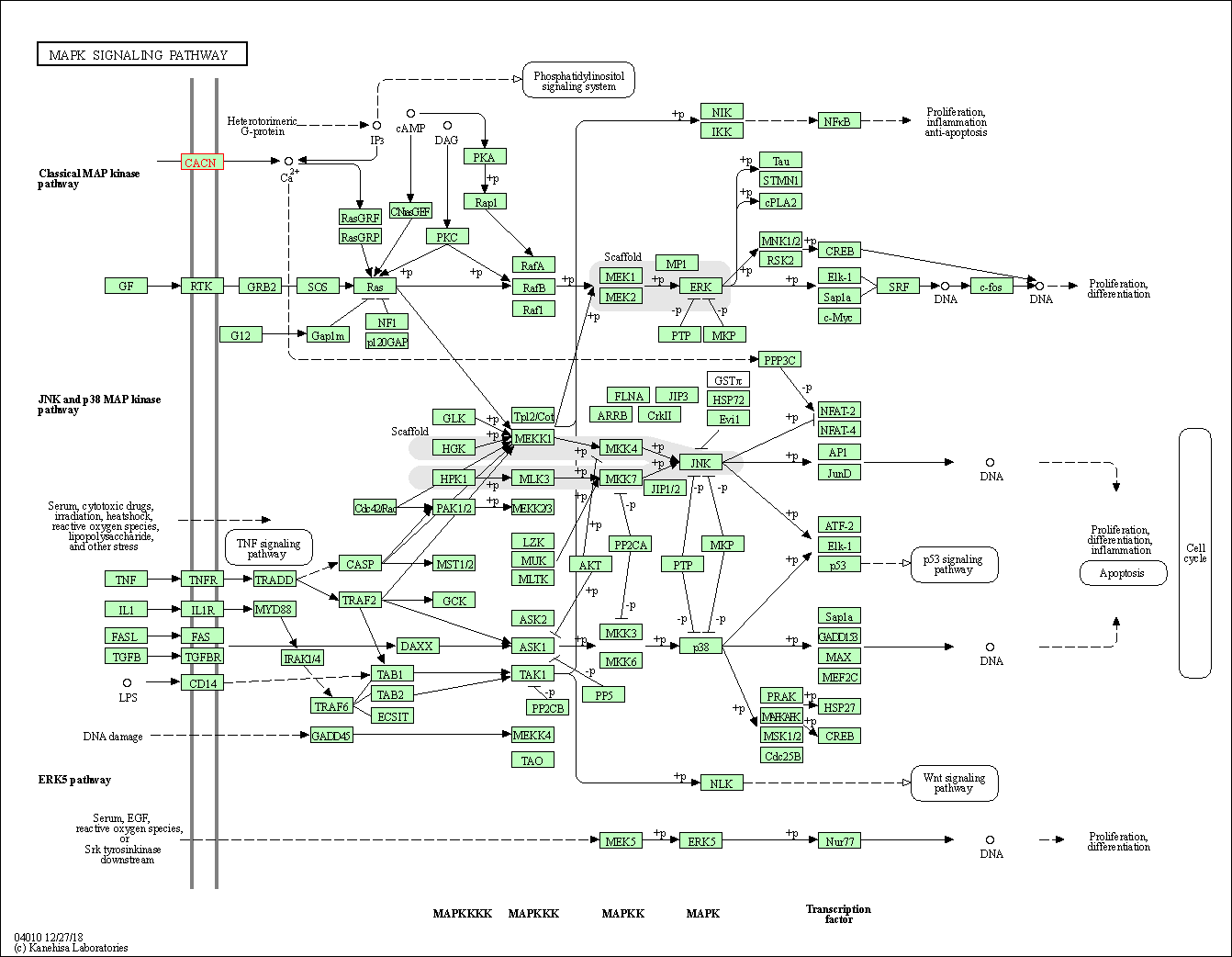
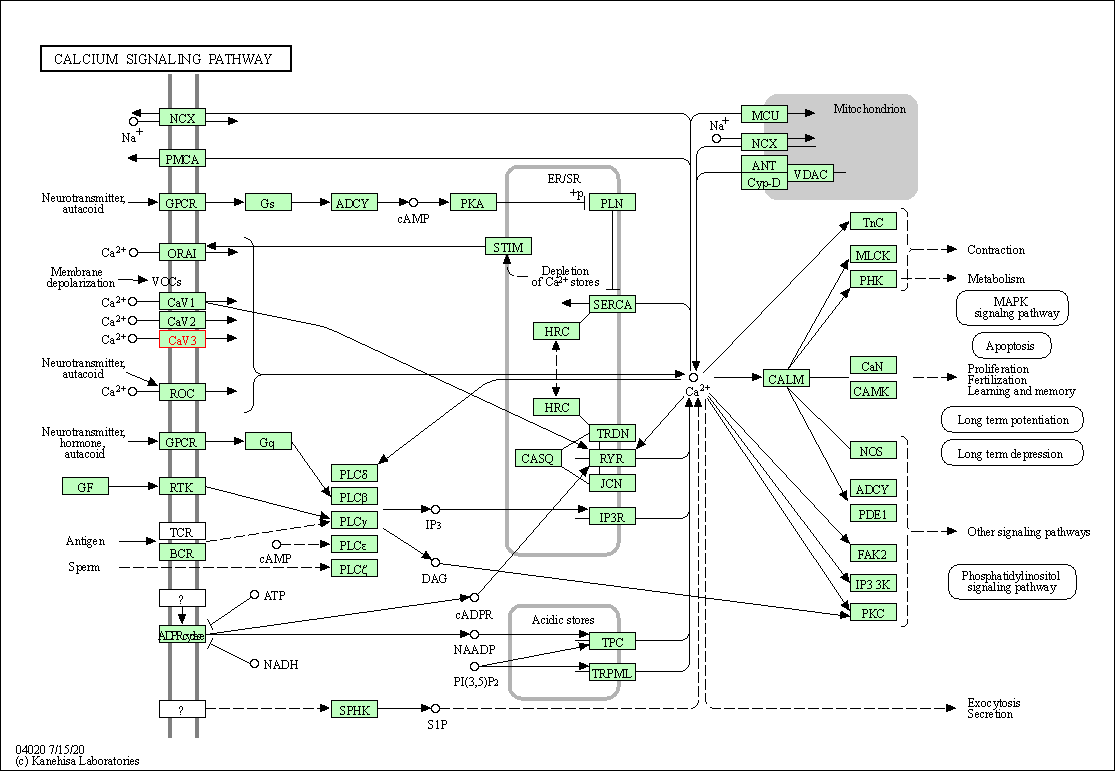
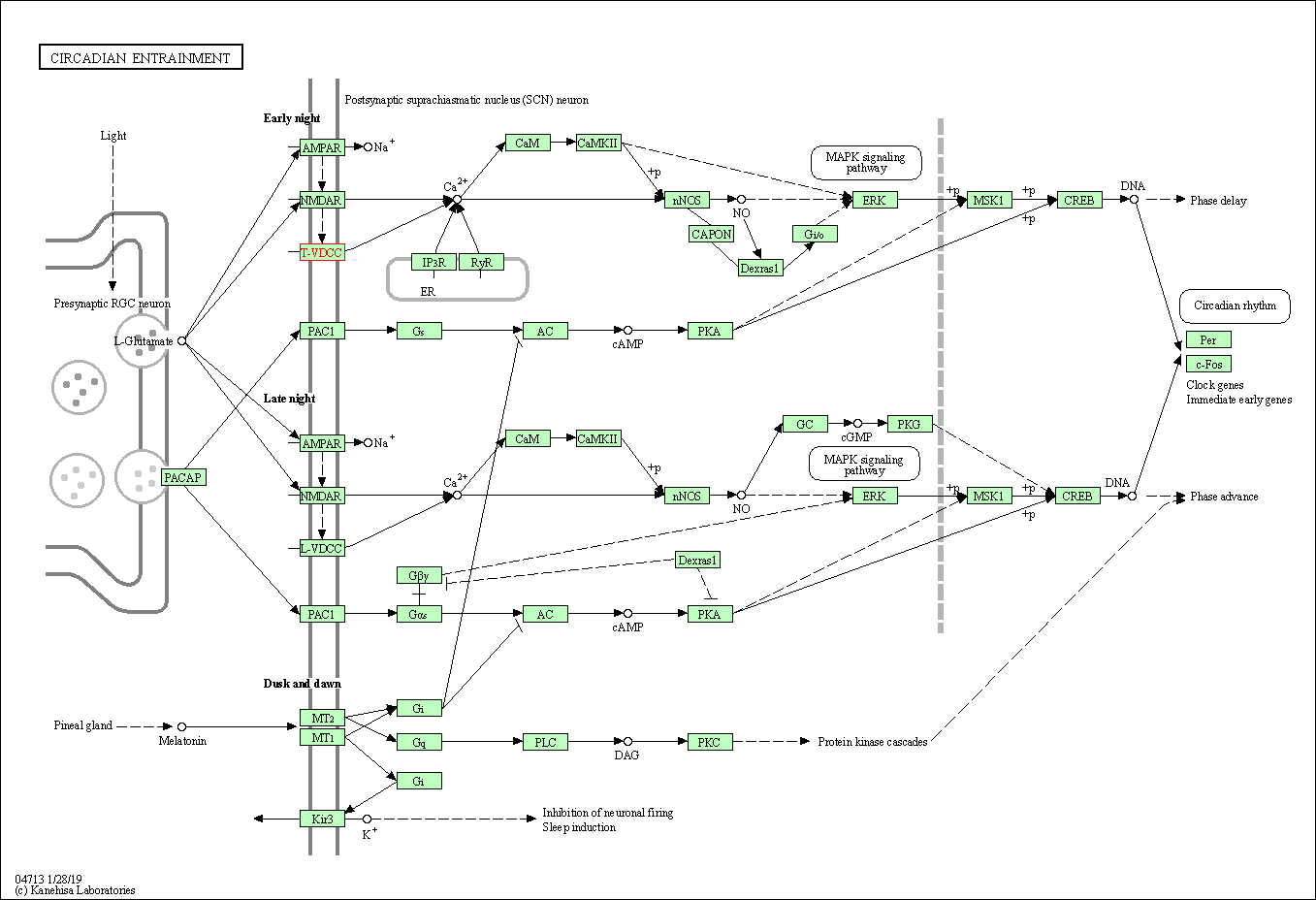
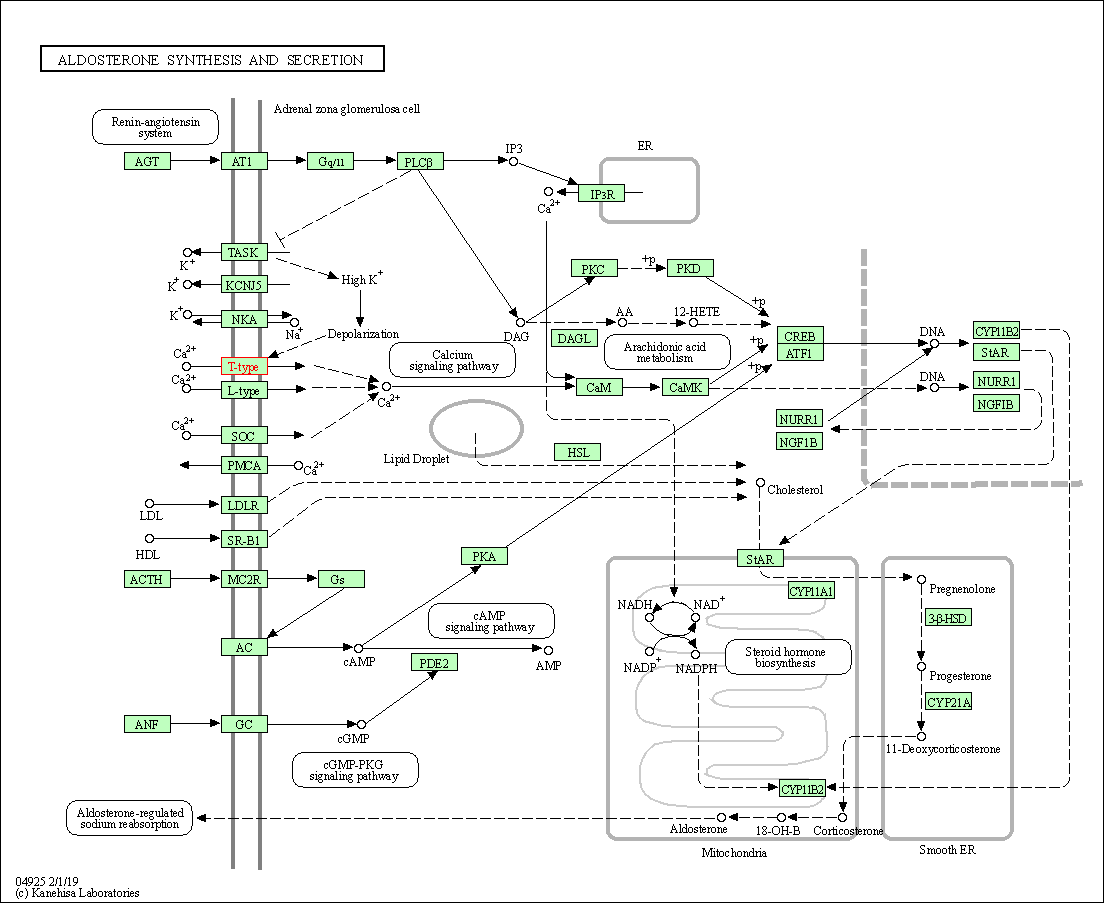
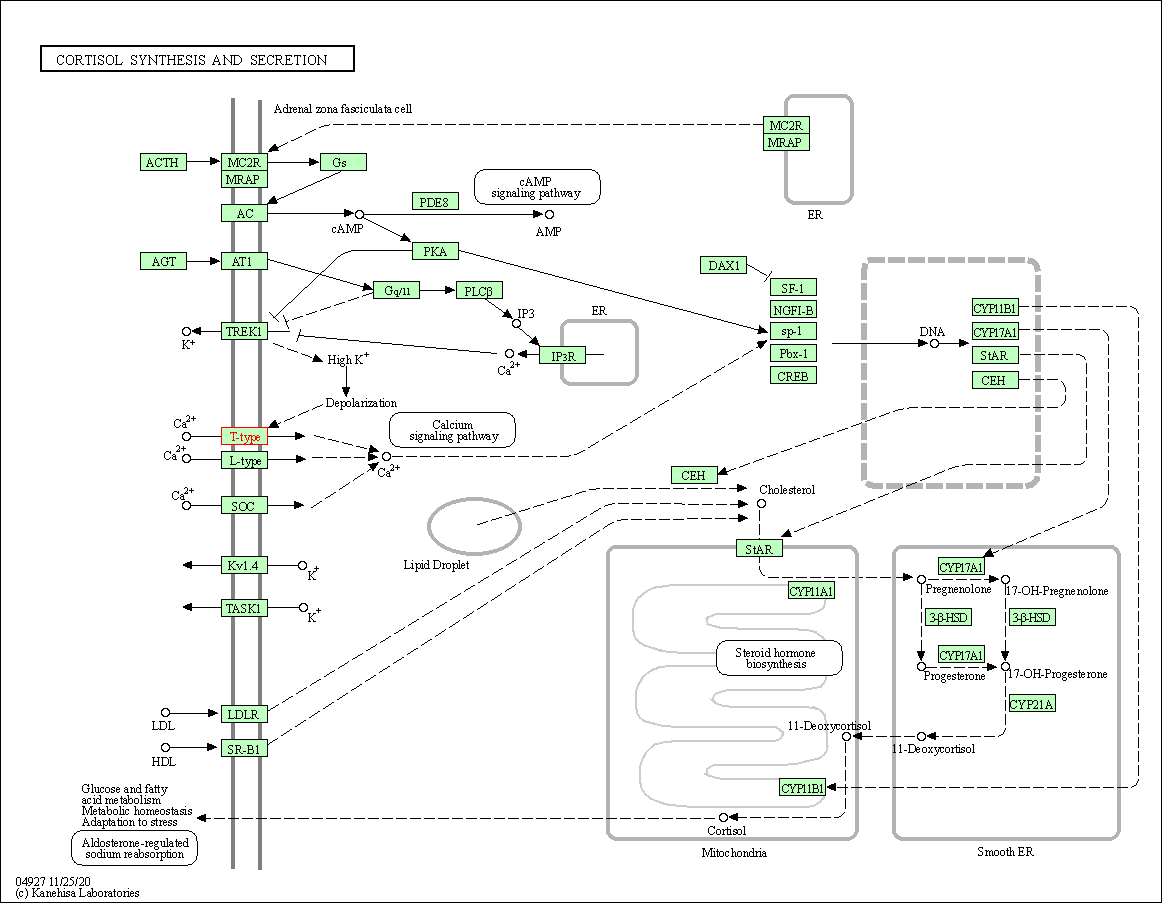
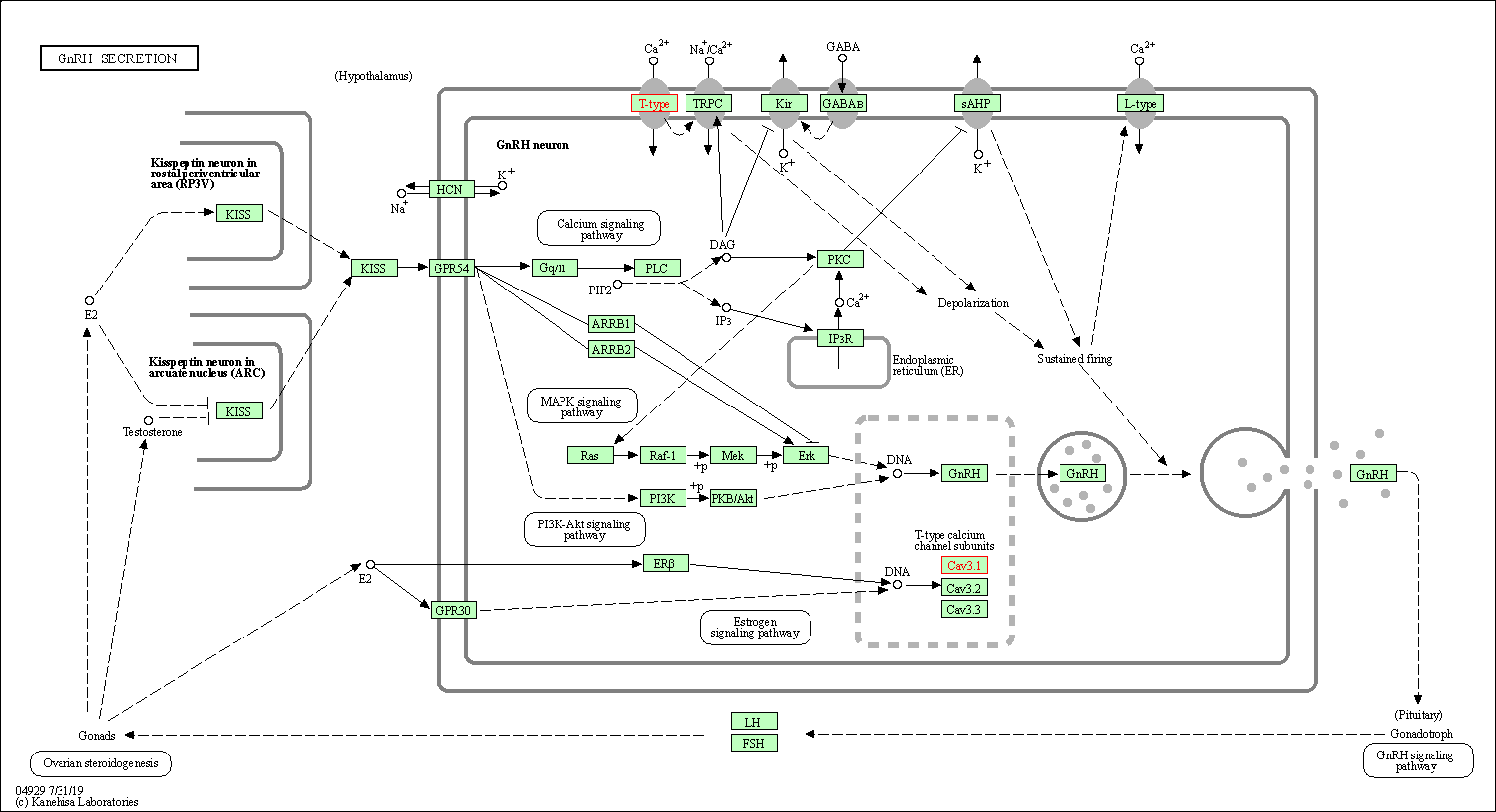
| KEGG Pathway | Pathway ID | Affiliated Target | Pathway Map |
|---|---|---|---|
| MAPK signaling pathway | hsa04010 | Affiliated Target |

|
| Class: Environmental Information Processing => Signal transduction | Pathway Hierarchy | ||
| Calcium signaling pathway | hsa04020 | Affiliated Target |

|
| Class: Environmental Information Processing => Signal transduction | Pathway Hierarchy | ||
| Circadian entrainment | hsa04713 | Affiliated Target |

|
| Class: Organismal Systems => Environmental adaptation | Pathway Hierarchy | ||
| Aldosterone synthesis and secretion | hsa04925 | Affiliated Target |

|
| Class: Organismal Systems => Endocrine system | Pathway Hierarchy | ||
| Cortisol synthesis and secretion | hsa04927 | Affiliated Target |

|
| Class: Organismal Systems => Endocrine system | Pathway Hierarchy | ||
| GnRH secretion | hsa04929 | Affiliated Target |

|
| Class: Organismal Systems => Endocrine system | Pathway Hierarchy | ||
| Click to Show/Hide the Information of Affiliated Human Pathways | |||
| Chemical Structure based Activity Landscape of Target | Top |
|---|---|
| Drug Property Profile of Target | Top | |
|---|---|---|
| (1) Molecular Weight (mw) based Drug Clustering | (2) Octanol/Water Partition Coefficient (xlogp) based Drug Clustering | |
|
|
||
| (3) Hydrogen Bond Donor Count (hbonddonor) based Drug Clustering | (4) Hydrogen Bond Acceptor Count (hbondacc) based Drug Clustering | |
|
|
||
| (5) Rotatable Bond Count (rotbonds) based Drug Clustering | (6) Topological Polar Surface Area (polararea) based Drug Clustering | |
|
|
||
| "RO5" indicates the cutoff set by lipinski's rule of five; "D123AB" colored in GREEN denotes the no violation of any cutoff in lipinski's rule of five; "D123AB" colored in PURPLE refers to the violation of only one cutoff in lipinski's rule of five; "D123AB" colored in BLACK represents the violation of more than one cutoffs in lipinski's rule of five | ||
| Co-Targets | Top | |||||
|---|---|---|---|---|---|---|
| Co-Targets | ||||||
| Target Poor or Non Binders | Top | |||||
|---|---|---|---|---|---|---|
| Target Poor or Non Binders | ||||||
| Target Profiles in Patients | Top | |||||
|---|---|---|---|---|---|---|
| Target Expression Profile (TEP) |
||||||
| Target Affiliated Biological Pathways | Top | |||||
|---|---|---|---|---|---|---|
| KEGG Pathway | [+] 4 KEGG Pathways | + | ||||
| 1 | MAPK signaling pathway | |||||
| 2 | Calcium signaling pathway | |||||
| 3 | Circadian entrainment | |||||
| 4 | Type II diabetes mellitus | |||||
| Panther Pathway | [+] 3 Panther Pathways | + | ||||
| 1 | Endogenous cannabinoid signaling | |||||
| 2 | GABA-B receptor II signaling | |||||
| 3 | Nicotine pharmacodynamics pathway | |||||
| Pathwhiz Pathway | [+] 1 Pathwhiz Pathways | + | ||||
| 1 | Muscle/Heart Contraction | |||||
| PID Pathway | [+] 1 PID Pathways | + | ||||
| 1 | Regulation of nuclear beta catenin signaling and target gene transcription | |||||
| Reactome | [+] 1 Reactome Pathways | + | ||||
| 1 | NCAM1 interactions | |||||
| WikiPathways | [+] 2 WikiPathways | + | ||||
| 1 | NCAM signaling for neurite out-growth | |||||
| 2 | Nicotine Activity on Chromaffin Cells | |||||
| Target-Related Models and Studies | Top | |||||
|---|---|---|---|---|---|---|
| Target Validation | ||||||
| References | Top | |||||
|---|---|---|---|---|---|---|
| REF 1 | Mechanism of tissue-selective drug action in the cardiovascular system. Mol Interv. 2005 Apr;5(2):84-93. | |||||
| REF 2 | URL: http://www.guidetopharmacology.org Nucleic Acids Res. 2015 Oct 12. pii: gkv1037. The IUPHAR/BPS Guide to PHARMACOLOGY in 2016: towards curated quantitative interactions between 1300 protein targets and 6000 ligands. (Ligand id: 7182). | |||||
| REF 3 | FDA Approved Drug Products from FDA Official Website. 2009. Application Number: (ANDA) 040253. | |||||
| REF 4 | URL: http://www.guidetopharmacology.org Nucleic Acids Res. 2015 Oct 12. pii: gkv1037. The IUPHAR/BPS Guide to PHARMACOLOGY in 2016: towards curated quantitative interactions between 1300 protein targets and 6000 ligands. (Ligand id: 7228). | |||||
| REF 5 | FDA Approved Drug Products from FDA Official Website. 2009. Application Number: (NDA) 010596. | |||||
| REF 6 | URL: http://www.guidetopharmacology.org Nucleic Acids Res. 2015 Oct 12. pii: gkv1037. The IUPHAR/BPS Guide to PHARMACOLOGY in 2016: towards curated quantitative interactions between 1300 protein targets and 6000 ligands. (Ligand id: 7261). | |||||
| REF 7 | FDA Approved Drug Products from FDA Official Website. 2009. Application Number: (NDA) 006800. | |||||
| REF 8 | Drugs@FDA. U.S. Food and Drug Administration. U.S. Department of Health & Human Services. 2015 | |||||
| REF 9 | URL: http://www.guidetopharmacology.org Nucleic Acids Res. 2015 Oct 12. pii: gkv1037. The IUPHAR/BPS Guide to PHARMACOLOGY in 2016: towards curated quantitative interactions between 1300 protein targets and 6000 ligands. (Ligand id: 7316). | |||||
| REF 10 | FDA Approved Drug Products from FDA Official Website. 2009. Application Number: (NDA) 005856. | |||||
| REF 11 | URL: http://www.guidetopharmacology.org Nucleic Acids Res. 2015 Oct 12. pii: gkv1037. The IUPHAR/BPS Guide to PHARMACOLOGY in 2016: towards curated quantitative interactions between 1300 protein targets and 6000 ligands. (Ligand id: 2406). | |||||
| REF 12 | Partial restoration of mutant enzyme homeostasis in three distinct lysosomal storage disease cell lines by altering calcium homeostasis. PLoS Biol. 2008 Feb;6(2):e26. | |||||
| REF 13 | Synthesis and in vivo evaluation of bicyclic gababutins. Bioorg Med Chem Lett. 2010 Jan 15;20(2):461-4. | |||||
| REF 14 | URL: http://www.guidetopharmacology.org Nucleic Acids Res. 2015 Oct 12. pii: gkv1037. The IUPHAR/BPS Guide to PHARMACOLOGY in 2016: towards curated quantitative interactions between 1300 protein targets and 6000 ligands. (Ligand id: 979). | |||||
| REF 15 | The pipeline and future of drug development in schizophrenia. Mol Psychiatry. 2007 Oct;12(10):904-22. | |||||
| REF 16 | Maladaptive homeostatic plasticity in a rodent model of central pain syndrome: thalamic hyperexcitability after spinothalamic tract lesions. J Neurosci. 2008 Nov 12;28(46):11959-69. | |||||
| REF 17 | Block of cloned human T-type calcium channels by succinimide antiepileptic drugs. Mol Pharmacol. 2001 Nov;60(5):1121-32. | |||||
| REF 18 | Effects of ethosuximide, a T-type Ca(2+) channel blocker, on dorsal horn neuronal responses in rats. Eur J Pharmacol. 2001 Mar;415(2-3):141-9. | |||||
| REF 19 | Prophylactic and therapeutic functions of T-type calcium blockers against noise-induced hearing loss. Hear Res. 2007 Apr;226(1-2):52-60. | |||||
| REF 20 | Differential inhibition of T-type calcium channels by neuroleptics. J Neurosci. 2002 Jan 15;22(2):396-403. | |||||
| REF 21 | Combination therapy and target organ protection in hypertension and diabetes mellitus. Am J Hypertens. 1997 Sep;10(9 Pt 2):198S-201S. | |||||
| REF 22 | Pfizer. Product Development Pipeline. March 31 2009. | |||||
| REF 23 | Identification of R(-)-isomer of efonidipine as a selective blocker of T-type Ca2+ channels. Br J Pharmacol. 2004 Dec;143(8):1050-7. | |||||
| REF 24 | Morpholin-2-one derivatives as novel selective T-type Ca2+ channel blockers. Bioorg Med Chem Lett. 2006 Oct 1;16(19):5244-8. | |||||
| REF 25 | Novel T-type calcium channel blockers: dioxoquinazoline carboxamide derivatives. Bioorg Med Chem. 2007 Jan 1;15(1):365-73. | |||||
| REF 26 | Discovery of potent T-type calcium channel blocker. Bioorg Med Chem Lett. 2007 Nov 1;17(21):5740-3. | |||||
| REF 27 | 3,4-Dihydroquinazoline derivatives as novel selective T-type Ca2+ channel blockers. Bioorg Med Chem Lett. 2004 Jul 5;14(13):3379-84. | |||||
| REF 28 | 3D pharmacophore based virtual screening of T-type calcium channel blockers. Bioorg Med Chem. 2007 Jan 15;15(2):1091-105. | |||||
| REF 29 | T-type Ca2+ channel blockers suppress the growth of human cancer cells. Bioorg Med Chem Lett. 2008 Jul 15;18(14):3899-901. | |||||
| REF 30 | Synthesis and biological evaluation of novel T-type calcium channel blockers. Bioorg Med Chem Lett. 2007 Jan 15;17(2):471-5. | |||||
| REF 31 | Growth inhibition of human cancer cells in vitro by T-type calcium channel blockers. Bioorg Med Chem Lett. 2006 Oct 1;16(19):5014-7. | |||||
| REF 32 | The Discovery and Characterization of ML218: A Novel, Centrally Active T-Type Calcium Channel Inhibitor with Robust Effects in STN Neurons and in a Rodent Model of Parkinson's Disease. ACS Chem Neurosci. 2011 Dec 21;2(12):730-742. | |||||
| REF 33 | T-type calcium channels facilitate insulin secretion by enhancing general excitability in the insulin-secreting beta-cell line, INS-1. Endocrinology. 1997 Sep;138(9):3735-40. | |||||
| REF 34 | Cryo-EM structures of apo and antagonist-bound human Ca(v)3.1. Nature. 2019 Dec;576(7787):492-497. | |||||
If You Find Any Error in Data or Bug in Web Service, Please Kindly Report It to Dr. Zhou and Dr. Zhang.

